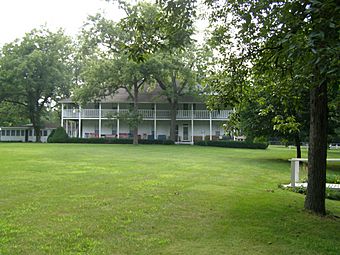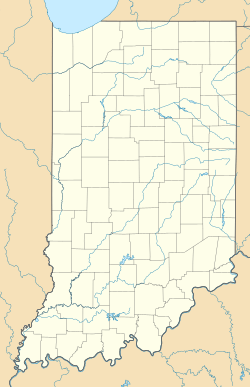Fountain Park Chautauqua facts for kids
Quick facts for kids |
|
|
Fountain Park Chautauqua
|
|
 |
|
| Location | 6244 W. Cty Rd. 1600S, Remington, Indiana |
|---|---|
| Area | 17.3 acres (7.0 ha) |
| Built | 1895 |
| Architectural style | Resort cottage |
| NRHP reference No. | 01001351 |
| Added to NRHP | December 07, 2001 |
Fountain Park has been a special place since 1895. It hosts a yearly event called a Chautauqua. This event helps people learn and grow. It also shares important values. The park was added to the National Register of Historic Places on December 7, 2001.
Long ago, Indiana had about 85 Chautauqua events. Today, only six still happen. These are in cities like Columbus, Jeffersonville, Madison, Merom, Remington, and Rome City. Most of these are weekend festivals. They feature art, music, crafts, and history plays.
The Fountain Park Chautauqua is different. It is a two-week event. It includes Sunday School and church services. It also has fun family activities. These include singing groups, bands, and speakers. You can also find art classes and talent shows. Fountain Park is special because it has permanent buildings. These were built just for the Chautauqua. They include a large meeting hall, a recreation building, a hotel, and 70 small cottages.
Contents
What is a Chautauqua?
The Chautauqua movement is important in American history. It helped bring culture and education to many people. This movement started in 1874. It quickly became very popular across the country.
At its peak, historians think about 30 million people attended Chautauquas. These events happened in 12,000 communities each summer. The first Chautauqua began in 1874. It was in Chautauqua, New York. It started as a training camp for Sunday school teachers.
A Methodist minister, John H. Vincent, and Lewis Miller created the idea. They co-founded the Chautauqua Lake Sunday School Assembly Program. This program first focused on religious education. But it soon added music, art, and other school subjects.
The first Chautauqua was a huge success. The idea spread fast across America. Many independent Chautauquas started up. They were like the "Mother Chautauqua" in New York. The Chautauqua movement was most popular around 1924-1925. From the 1880s to the Great Depression, Chautauqua was a way for people to learn. It brought culture to thousands of towns. These towns were often far from big cities.
History of Fountain Park
Fountain Park was founded in 1895. It is about a mile north of Remington, Indiana. It is located in Jasper County, Indiana. Robert Parker, a bank president, had an idea. He wanted a yearly meeting. People could discuss religion, science, and books there. He bought the land for Fountain Park in 1893.
Fun activities were also part of the program. These included boating, swimming, and shuffleboard. There were also sports contests. Parker bought 70 acres of land. He thought its natural beauty was perfect. It was an ideal place for an outdoor meeting. People from Northwestern Indiana could meet there. They would discuss religious, scientific, and literary topics.
Before the first meeting in 1895, Parker built a large meeting hall and a restaurant. The meeting lasted ten days. It cost $1.00 per person. The Fountain Park Company started in 1897. Parker was its president. By 1898, a 36-room hotel was built. A dam was also built on Carpenter Creek. This created a small lake for boating and swimming. The dam was later removed. It blocked water flow to Remington.
Early Development
The first permanent cottages were built between 1898 and 1899. The Sherman White family and the George Ball family built them. As more cottages appeared, owners wanted them on the edges of the park. They wanted to keep the main grove clear. Fountain Park became a popular spot. It offered telephone service and mail delivery. There was also grocery service. Natural springs provided mineral water. People could camp in tents. There was a hotel and a restaurant.
The park was easy to reach. It was one mile from Remington. It also had a stop on the Pittsburgh, Cincinnati, Chicago and St. Louis Railroad line. This made it easy to get to from Chicago. Horse-drawn taxis ran from Remington during the meetings.
In 1901, the Pennsylvania Railroad offered special travel deals. People started to see the benefits of the assembly. Famous speakers came to the park. These included temperance speakers and religious leaders. Politicians, poets, and musicians also performed. Some famous visitors were ex-U.S. Senator John Ingalls, Billy Sunday, and William Jennings Bryan. William Jennings Bryan visited four times. Other guests included Paul Harvey and Governor Robert M. La Follette. World War I hero Pat O'Brien also spoke. Billy Sunday's widow also gave a short speech. William Jennings Bryan and Pat O'Brien had the most attendees ever.
One Senator described Fountain Park beautifully. He said it was a place where great people met. They shared their best ideas. It was a place for freedom and rest. It offered hope for the future and memories of joy. He believed no other 30 acres in the world had hosted so many great people. They shared so many good thoughts in the same amount of time. It was a place for religion, history, and good living. It was about higher goals, education, music, and friendship. It was not about making money.
Changes Over Time
Until 1902, the Assembly was run as a Christian church project. That year, it became a company. In 1904, it became a joint stock company. The Fountain Park Company then leased 30 acres from Robert Parker and his wife. They paid $50 per year for 25 years.
In 1907, cars were allowed into the park for the first time. The original entrance was on the east side. It was used for taxis. As more people used cars, a new gate opened in 1912. This gate on the west side was only for cars. Eventually, both these gates closed. The north gate became the only way in or out.
In 1908, the founder, Robert Parker, stepped down. In May 1909, Christian and Margaret Hensler bought the property. They leased about 30 acres to Fountain Park. Later, a legal issue divided the land. It became the current 17.3 acres. In 1911, the Women's Improvement Association started. They helped make the grounds and buildings better. The next year, electric lights were installed.
Fountain Park stayed open during the Great Depression. It also stayed open during both World Wars. During World War I, all lights were turned off after evening programs in 1918. In 1933, the Great Depression caused the session to be moved by one week. In 1942, they decided Fountain Park would still open. But rationing during World War II lowered attendance in 1943.
Between 1956 and 1961, big changes happened. The old food stand was replaced. A new meeting hall was built. A new entrance gate was added on the north side. A new fountain was designed. A new recreation hall was also built.
Today, the Fowler Methodist Church holds a family event there each year. Boy and Girl Scouts use the grounds. Local schools also use it for day camps and other events.
Exploring the Grounds
The Fountain Park Chautauqua is north of Remington, Indiana. It is in a farming area of Jasper County. The 17.3 acres are heavily wooded. You can find oak, hickory, walnut, and wild cherry trees. Carpenter Creek runs along the property. The park has small cottages. It also has a few larger buildings. These are for learning, fun, and living. The main entrance is on the north side. A circular road goes around the camp. Six cottages and some small buildings are outside this road loop. These include two old outdoor restrooms.
At the center of the camp is a fountain and a gazebo. This is why it's called "Fountain Park." Around the central circle are the main meeting hall, the Recreation Building, and food stands. There is also an Art Colony and museum. The Well House and Brick Shelter are also there. You can also find shuffleboard lanes, a basketball court, and a playground. There are benches, swings, and flower planters. Two stone planters are from 1932. The only public building not in this central circle is the hotel. It is on the west side of the grounds.
The way the grounds are designed is important. The winding road and cottages along its edge create a special space. Catalpa trees were planted to shade the cottages. Catalpas were popular in the 1800s and 1900s. Their wide leaves give good shade. Their flowers have a sweet smell in early summer. By 1917, there were 48 cottages. The cottages are on small lots and are very close together.
Most cottages are one and a half stories tall. They have a pointed roof in front. They also have a one-story open front porch. The front usually has a door and a window on the main floor. A single window is in the pointed roof above. Because the lots are small, cottages are often twice as deep as they are wide. Cottage number 32 is a good example. There is not much decoration. But a few have Gothic Revival style. This includes fancy trim and arched windows. Few cottages have fireplaces because they are used only for a short time.
Over time, different styles have appeared. Most newer buildings are on the south side of the road. Not all cottages are considered "contributing" to the historic value. These changes show the history of Fountain Park Chautauqua over 105 years.
Newer buildings fit in with the older ones. Some newer cottages have flatter roofs. Some are made of concrete blocks. One building has an A-frame design. All newer cottages are on lots meant for homes. So they look similar to the historic ones. In 1895, a wooden meeting hall was built. It was where the current one stands. In 1960, the old hall was torn down. The current one was built. The new hall is made of wood. It has a pointed roof. It is about the same size as the old one.
Important Structures
- The Brick Shelter is an open building. It has a concrete base. It was built early in Fountain Park's history. No exact date is known. Four brick posts hold up the roof. It used to have a water tank and pump. Now, it is a public gathering area.
- The Hotel was built in 1898. It is on the northwest side of the camp. It had 36 rooms. Five rooms were removed to add bathrooms. It also had a dining room that seated 130 people. It is L-shaped. It has a porch that goes around two sides.
- The Tabernacle is not the first building. But it stands in the same spot as the original from 1895. It is a rectangular building. It has vertical wood siding and a pointed roof. The sides can be opened for better airflow. Large red, white, and blue awnings can be extended. They give extra shade for big groups. The main entrance is on the west side. It opens to a middle aisle. This leads to the stage. The stage is from the original tabernacle. It has theater-style seats for 232 people. The ceiling has open steel beams. They are painted white. Modern fans and lights hang from these beams. The tabernacle was built in 1960. It replaced the 1895 structure.
- The Entry Gate was built in 1960. It is a small rectangular shed. It has limestone and vertical wood siding. It has a low, pointed roof with wide overhangs. The gates on either side of the driveways match. They have limestone posts and wood railings.
- The fountain in the center of the camp is not the original. There has always been a fountain in the park's history. An Indiana State Historical Marker is next to the fountain. It tells about the site.
Images for kids




